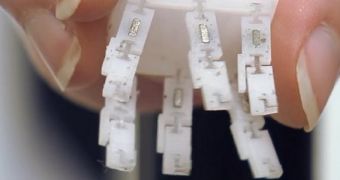Researchers at the University of Maryland, led by engineer Sarah Bergbreiter, are currently working on developing micro-robots that take inspiration from insects. These small-scale machines seek to replicate some of the most spectacular capabilities bugs have, such as being able to jump many body lengths forward or traveling extremely fast over rugged terrain.
The UM team is developing these capabilities in order to create robotic swarms that can travel over very rough terrain with ease. A series of significant applications is envisioned, such as using the micro-robots to investigate piles of debris formed following natural disasters. These machines could conceivably locate survivors buried under rubble much faster than via traditional methods.
The prototypes the team has already completed are no larger than the tip of your finger and are comparable in size, though smaller, to a penny. Considering the current level of miniaturization we are capable of, we can easily envision outfitting these machines with small video cameras or other sensors capable of assessing structural damage in buildings affected by earthquakes, for example.
Bergbreiter's team at UM is now using funds secured from the US National Science Foundation (NSF) to find a way of mimicking the properties exhibited by insect legs. These are easily the most difficult thing to replicate, since engineers need to find a way of storing the energy needed for speed bursts and huge jumps in mechanical devices. From a certain point onwards, rubber bands become insufficient.
Being able to translate the performances of insect legs to millimeter-scale robots would however see these machines traveling over difficult terrain at very high speed, jumping very high to clear obstacles. The first step in this process is to create larger-scale robots for technology demonstrations and then scaling them down as much as needed and possible.
Even existing prototypes are very small. Engineers in Berbreiter's team are using microscopes to build the test versions of the new machines. Rather than using motors – which will be the next step – the group is currently using magnets to propel the robots forward. Eventually, the scientists say, these machines will become highly-capable and efficient mobile sensor platforms.
“This is a very worthwhile effort and is just the beginning of what we hope will be achieved in the future when these micro-robots are equipped with video sensors and wireless communications,” comments George Haddad, who is a program director with the Division of Electrical, Communications and Cyber Systems at the NSF Directorate for Engineering.
Bergbreiter says that such small robots could also have significant applications for the military, especially in the field of stealthy surveillance and intelligence gathering. It may prove to be possible to install a very small laser on these robots, allowing them to act as target acquisition assets during high-risk missions, analysts believe.

 14 DAY TRIAL //
14 DAY TRIAL //